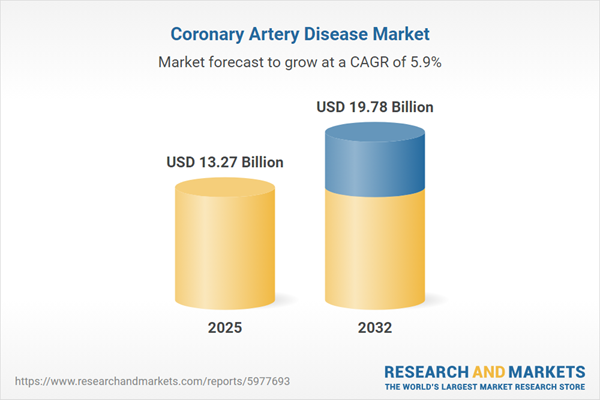Speak directly to the analyst to clarify any post sales queries you may have.
The coronary artery disease market is transforming rapidly, shaped by technological advances, evolving care models, and global regulatory shifts. For senior leaders, this research offers actionable insights into how innovation and strategic decision-making are redefining the landscape and unlocking new opportunities for growth and resilience.
Market Snapshot: Coronary Artery Disease Market Growth and Dynamics
The coronary artery disease market grew from USD 12.53 billion in 2024 to USD 13.27 billion in 2025. It is expected to continue expanding at a CAGR of 5.86%, reaching USD 19.78 billion by 2032. Growth is fueled by aging demographics, increased metabolic disorders, and rising adoption of innovative diagnostic and interventional solutions. Device manufacturers, healthcare providers, and payers must navigate a market subject to rapid product evolution, regulatory updates, and shifting care delivery models while addressing cost efficiency and market access.
Scope & Segmentation
Stakeholder strategies and planning can be optimized by understanding nuanced segment dynamics across devices, procedures, end users, and regions. This report examines:
- Product Types: Balloon catheters, coronary stents (bare metal stents, bioresorbable scaffolds, drug eluting stents), embolic protection devices, guidewires, imaging systems (intravascular ultrasound, optical coherence tomography)
- Procedure Types: Coronary artery bypass grafting (off pump, on pump); percutaneous coronary interventions (balloon angioplasty, stenting)
- End Users: Ambulatory surgical centers, cardiology clinics, hospitals
- Regional Coverage: Americas (United States, Canada, Mexico, Brazil, Argentina, Chile, Colombia, Peru); Europe, Middle East & Africa (United Kingdom, Germany, France, Russia, Italy, Spain, Netherlands, Sweden, Poland, Switzerland, United Arab Emirates, Saudi Arabia, Qatar, Turkey, Israel, South Africa, Nigeria, Egypt, Kenya); Asia-Pacific (China, India, Japan, Australia, South Korea, Indonesia, Thailand, Malaysia, Singapore, Taiwan)
- Company Analysis: Abbott Laboratories, Boston Scientific Corporation, Medtronic plc, Terumo Corporation, B. Braun Melsungen AG, Johnson & Johnson, Becton Dickinson and Company, Koninklijke Philips N.V., Edwards Lifesciences Corporation, Siemens Healthineers AG
The report provides segment-level analysis with a focus on devices like next-generation stents and imaging systems, evolving procedure modalities, and market-specific requirements across various regions.
Key Takeaways: Strategic Insights for Decision-Makers
- Advances in device design, such as drug-eluting stents and bioresorbable scaffolds, are improving clinical outcomes while driving product differentiation.
- Integrated care models, incorporating multidisciplinary teams, are accelerating patient-centric treatment planning and optimizing post-procedural rehabilitation.
- Emergence of hybrid operating suites and innovative imaging technologies supports seamless transitions between intervention types and enhances procedural guidance.
- Growth in digital health and artificial intelligence is reshaping clinical decision-making and supporting longitudinal patient monitoring, extending value beyond devices.
- Value-based care and outcome-linked payment models are aligning economic incentives with improved patient outcomes, shifting how providers and payers engage with device suppliers.
- Strategic collaborations and portfolio diversification among leading companies are enhancing competitive positioning and expanding access to emerging market opportunities.
Tariff Impact: Navigating Supply Chain and Cost Challenges
Impending U.S. tariff policies are expected to create supply chain complexity for coronary intervention device manufacturers. Many original equipment manufacturers are exploring near-sourcing and dual-sourcing to manage cost pressures, while distributors and hospitals anticipate shifts in device pricing and potential procedure cost increases. Companies are focusing on inventory optimization, domestic production, and policy advocacy to maintain continuity of supply and support patient access to coronary therapies.
Methodology & Data Sources
Research integrates comprehensive secondary analysis of industry literature, regulatory filings, and clinical registries with primary interviews from stakeholders including clinicians, procurement directors, and device executives. Cross-validation ensures robust, evidence-based insights and consensus-driven recommendations for strategic planning.
Why This Report Matters
- Enables leaders to identify emerging opportunities in both mature and developing coronary markets by segment, procedure, and geography.
- Guides investment in R&D, supply chain, and digital innovation to align with evolving care models and stakeholder expectations.
- Supports proactive risk management in response to changing regulatory, economic, and policy landscapes.
Conclusion
As the coronary artery disease market evolves, leadership must blend innovation, collaboration, and agility to capture growth and deliver improved patient care. Leveraging evidence-based insights will support resilience and sustained strategic advantage in this competitive landscape.
Additional Product Information:
- Purchase of this report includes 1 year online access with quarterly updates.
- This report can be updated on request. Please contact our Customer Experience team using the Ask a Question widget on our website.
Table of Contents
3. Executive Summary
4. Market Overview
7. Cumulative Impact of Artificial Intelligence 2025
Companies Mentioned
The companies profiled in this Coronary Artery Disease market report include:- Abbott Laboratories
- Boston Scientific Corporation
- Medtronic plc
- Terumo Corporation
- B. Braun Melsungen AG
- Johnson & Johnson
- Becton Dickinson and Company
- Koninklijke Philips N.V.
- Edwards Lifesciences Corporation
- Siemens Healthineers AG
Table Information
| Report Attribute | Details |
|---|---|
| No. of Pages | 193 |
| Published | November 2025 |
| Forecast Period | 2025 - 2032 |
| Estimated Market Value ( USD | $ 13.27 Billion |
| Forecasted Market Value ( USD | $ 19.78 Billion |
| Compound Annual Growth Rate | 5.8% |
| Regions Covered | Global |
| No. of Companies Mentioned | 11 |









